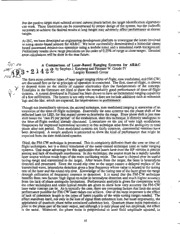
NASA Technical Reports Server (NTRS) 19930012233: A comparison of laser-based ranging systems for AR/C PDF
Preview NASA Technical Reports Server (NTRS) 19930012233: A comparison of laser-based ranging systems for AR/C
thatthepassivetargetmustsubtendseveraclamera pixels before the target identification algorithms can work. These limitations can be counteracted by proper design of the system, but the tradeoffs necessary to achieve the desired results at long ranges may adversely affect performance at shorter ranges. At JSC, we have developed an engineering development platform to investigate the issues involved in using stereo-based sensors for AR&C. We have successfully demonstrated a binocular stereo based automated rendezvous operation using a mobile robot and a simulated earth background. Preliminary results show range precisions on the order of 0.25% of range at close ranges. Detailed error calculations will be done in the near future. A Comparison of Laser-Based Ranging Systems for AR&C ,,';/_ __,' _-J '¢) q 2 1 4 2 2 bys ophoJ . W. rV Langley Research Center The three most common types of laser target ranging (time-of-flight, tone modulated, and FM-CW) are discussed first as far as principle of operation is concerned. The first, time-of-flight, is shown to depend more on the ability of support electronics than the fundamentals of the concept. Examples in the literature are cited to show the remarkably good performance of time-of-flight systems. A system developed in Finland has been shown to have an incremental ranging capability of a few millimeters. The system is not only robust; it does not include additions such as reference legs and the like, which are expected, for improvement in performance. Though not immediately obvious, the second technique, tone modulated ranging is somewhat of an extension of the time-of-flight technique. Essentially the tone systems use the phase shift of the reflected laser (or LED, for that matter) power to determine the range. Since phase shift is just time shift times the "two PI per period" of the modulation, then this technique is directly analogous to the time-of-flight method already discussed. Limitations on the use of very high modulation frequencies for improved incremental accuracy in this technique arise from the ambiguity in total phase after one period. Tone modulated systems are fairly common, commercial versions have been developed. A simple analysis is presented to show the kind of performance that might be expected from the tone modulated systems. Third, the FM-CW technique is presented. This is completely different from the tone or time-of- flight techniques, but is a direct translation of the same-named technique used in radar ranging systems. One major advantage for this application that lasers have over the RF version is precise aiming and lack of multipath interference. In this technique, the source must be a rapidly tunable laser source without mode hops of the main oscillating mode. The laser is chirped over its useful tuning range and transmitted to the target. After return from the target, the laser is heterodyne detected and processed. Since the round trip time to the target causes a delayed replica of the transmitted wave, heterodyne detection gives a beat frequency whose value is related to the tuning rate of the laser and the round-trip time. Knowledge of the tuning rate of the laser gives the range through utilization of frequency counters or detectors. It is noted that the FM-CW technique benefits from two factors: high signal-to-noise in heterodyne detection and much higher accuracy from the lack of phase ambiguity limitations. Performance analysis is given for comparison with the other techniques and some typical results are given to show how very accurate the FM-CW laser radar concept can be. As is typically the case, there are competing factors that limit the actual performance possible for FM-CW laser radars can achieve. One of the most important is the effect of lack of coherence length in the types of lasers capable of the wide tuning ranges needed. The effect manifests itself, not only in the loss of signal from coherence loss, but more importantly, the appearance of quantum phase noise associated coherence loss. Quantum phase noise represents a jitter in the phase part of the laser output, and although it is only phase and not amplitude, the effect is the same. Moreover, the phase noise is proportional to laser field amplitude squared, as 15 contrastedtothefirst powerfield for theidealizedheterodynequantumnoiselimited case.The overalleffectis toplacefar morestringentrequirementsonthetypeof lasersourceusedthan wouldbeotherwise.Thema_tude of thisproblemis illustratedin asimplecasetoshowhow muchreductionmayoccurin performance.Lasersourcesotherthanthecurrentlyusedlaser diodesmayalleviatetheproblemtoaconsiderabledegreewithsomereductioninperformancedue tothemorelimitedfrequencysweep. In conclusion, it may be said that the FM-CW laser radar concept has already demonstrated considerable capability, and that limitations on performance stem from characteristics of laser sources which are constantly improving. Given this trend, it seems apparent that the FM-CW laser radar will clearly represent a considerable competitor for the time-of-flight technique and its close cousin, the tone modulated method. _ _ _ ,,D , . Demonstration of Automated Proximity and Docking Technologies By Robert Anderson, Roy Tsugawa/TRW and ThomaBsryanM, SFC ! An autodock was demonstrated using straightforward techniques and real sensor hardware. A _-- simulation testbed was established and validated. : The sensor design was refined with improved optical performance and image processing noise mitigation techniques, and is ready for production from off-the-shelf components. The autonomous spacecraft architecture is defined. The areas of sensors, docking hardware, propulsion, and avionics are included in the design. The Guidance Navigation and Control architecture and requirements are developed. Modular structures suitable for automated control are used. The spacecraft system manager functions including configuration, resource and redundancy management are defined. The requirements for autonomous spacecraft executive are defined. High level decisionmaking, mission planning, and mission contingency recovery are a pan of this. The next step is to do flight demonstrations. After the presentation the following question was asked. How do you define validation? There are •two components to validation definition: software simulation with formal and vigorous validation, and hardware and facility performance validated with respect to software already validated against analytical profile. 16
